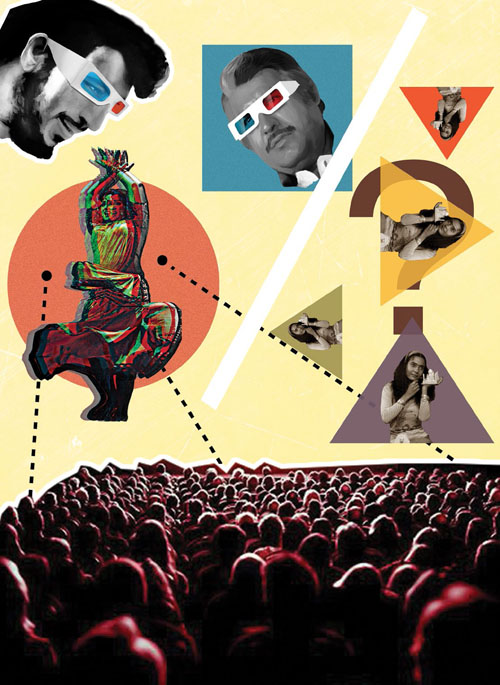Considering the rerelease of two classic, high-nostalgia films – one a cult favourite, the other an all-time blockbuster – Thomas Crowley reflects on how and why we process the past and what it says about about the present.
2013 may have marked 100 years of Indian cinema, but the nostalgia party has continued into 2014. On January 3, after two years of build-up, Sholay was re-released nationwide, in 3D. Does the world really need another theatrical release of Sholay, perhaps the most iconic Bollywood film of all time? And is it possible to get a clear-headed look at the aesthetics, the politics and the larger meaning of Sholay, in this midst of all the nostalgic haze?
The conversion to 3D is hard to regard as anything but a cheap marketing ploy, an attempt to cash in on the film’s enduring popularity. The ubiquity and familiarity of Sholayspeak is the main theme of the trailer for the 3D version, which is little more than a careful cataloging of all the film’s most famous lines.
But Sholay was not the only old film to grace multiplexes across the country in the early months of 2014. There was another retro release, though this one came with much less fanfare and an infinitesimally smaller advertising budget: the commercial release, at long last, of Kamal Swaroop’s 1988 masterpiece Om Dar-Ba-Dar. The film bounced around the festival circuit during its initial release, but had not been shown in cinemas in India. Om Dar-Ba-Dar thus has none of Sholay’s ubiquity; but for the film’s devoted following, Om Dar-Ba-Dar’s dialogues and songs are just as lovingly remembered and winkingly quoted.
Sholay was released just six weeks after Indira Gandhi imposed the Emergency. With its story of a government servant going beyond the law to restore order to an errant society, Sholay has uncomfortable, if unintentional, resonances with the Emergency.
Both films then, are founts of nostalgia, albeit in different ways. And they enter the cinemas in the midst of a veritable blizzard of filmic throwbacks, which include other re-releases, and newer films, both alternative (Gangs of Wasseypur) and mainstream (Gunday being only the latest example). Why this proliferation at this moment in time? Nostalgia, of course, can strike at any time – people are always looking back to a (non-existent) glorious past. And the past is nostalgised in cycles, with certain eras getting the sentimental treatment as they fade further into memory. But there is also evidence that nostalgia surges in unsettled times. And there does seem to be a churning in India – a widespread discontent with growing inequality, rising prices, regressive sexual norms, and an increasingly obvious, rapacious business/ politics nexus. The anti-corruption movement, the protests against sexual violence: these can be read as surface-level manifestations of a much deeper malaise.
Unease with current times does not automatically lead to progressive change; it can just as easily lead to regressive fantasies, as the Tea Party movement in the United States has shown. Perhaps it is not too much of a stretch to put the Sholay nostalgia in this context.
On the face of it, Sholay nostalgia seems innocent enough, a celebration of the film’s ‘70s style and its familiar themes – the disco inspired clothing of the two heroes, the bromance that borders on camp, the warm, fuzzy portrait of harmonious village life. But many film scholars have pointed to the ultimately reactionary nature of Sholay’s plot, in which a feudal landlord (Thakur) hires goons to do his bidding and restore peace to a tight-knit village community. Could this be part of its modern-day appeal?
This may be oversimplifying. A look at the context of Sholay complicates the matter. By chance, Sholay was released just six weeks after Indira Gandhi imposed the Emergency. With its story of a government servant going beyond the law to restore order to an errant society, Sholay has uncomfortable, if unintentional, resonances with the Emergency.
In this context, it becomes more difficult to read Sholay nostalgically, as a paean to the simplicity of village life. But then, the whole impulse of nostalgia is to wish away such inconvenient historical facts.
The nostalgia over Om Dar-Ba-Dar is of an entirely different nature. In fact, Om Dar-Ba-Dar is, in some ways, the anti- Sholay. While Sholay is the gold standard of Bollywood films, Om Dar-Ba-Dar is, in the words of an anonymous blogger, the “antithesis to whatever is recognised globally as Indian cinema.” And yet Om Dar-Ba-Dar is much more than a reverse image of Sholay; it is in many ways a sly commentary on, and an active critique of, the typical Bollywood tropes that Sholay embodies, including the item number, the quaint depiction of small-town India and the sentimental, “till-death-do-us-part” romance.
And yet, despite – or perhaps because of – its satirical depiction of 1980s, small-town life (rote memorisation in the classroom, love and longing via Vividh Bharati, superstition and commerce in equal measure), Om Dar-Ba-Dar strikes a nostalgic chord for those who lived through those times. Released just before the era of liberalisation, the film captures the idiosyncrasies of life outside the global marketplace. For all its surrealism, it has a very real grasp of the textures of those times (including many references to caste in the age of Mandal). Even as it lampoons small-town conventions, it evokes nostalgia for a now-distant age.
Adding to the nostalgia are the memories of how one discovered this underground gem. From a single VHS cassette, Om Dar-Ba-Dar was copied so many times that later copies only had sound – the images were corrupted to the point of total illegibility. The movie eventually made its way online, and found a new audience through the world of torrents. Passed on from friend to friend like a secret treasure, the film – and the chase involved in hunting it down – plays a key role in the nostalgic memory of many cineastes. If Sholay is a contemporary Ramayana or Mahabharata in the way it has seeped into the collective consciousness, Om Dar-Ba-Dar is an obscure Tantric text discussed in whispers by a sensuous group of initiates. (Sadly, the current release of the film did little to bring it to a wider audience, as it played only in select urban multiplexes as part of the “PVR Rare” line.)
Om Dar-Ba-Dar is much more than a reverse image of Sholay; it is in many ways a sly commentary on, and an active critique of, the typical Bollywood tropes that Sholay embodies, including the item number, the quaint depiction of smalltown India and the sentimental, “till-deathdo- us-part” romance
But beyond the nostalgia, what kind of film is Om Dar- Ba-Dar? Although many have thrown their hands in the air and declared that the film can’t be described – or that it is, for the lack of a better word, “postmodern” – this seems like a cop-out. True, the film is wildly experimental and full of non sequiturs. It is often compared to an acid trip, and with good reason. But one comes away with the feeling that there’s a method to the madness. For all its supposed incoherence, Om Dar-Ba-Dar at all times bears the imprint of its auteur director. The film is Swaroop’s meditation – or perhaps more accurately, his hallucination – on adolescence, politics, religion, education, money and terrorist tadpoles. It is his biting, jumpy, ecstatic vision that animates the film from start to finish. In fact, in many ways, Om Dar- Ba-Dar resembles Finnegan’s Wake, the final work of the arch-modernist author James Joyce: both Joyce and Swaroop described their works as invocations of the language of the night and the logic of dreams.
What if Sholay is really the postmodern film? Doesn’t the film presage the brutal revenge fantasies, the genre mashups and the ever-present homages that made that quintessential post-modernist, Quentin Tarantino, so popular two decades later? I know this is a contrarian argument, but perhaps such questions will shake up debate around both mainstream and alternative classics, pushing them out of the nostalgic hazes in which they now lie.














